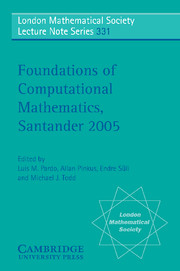Book contents
- Frontmatter
- Contents
- Preface
- 1 Non Universal Polynomial Equation Solving
- 2 Toward Accurate Polynomial Evaluation in Rounded Arithmetic
- 3 Sparse Grids for Higher Dimensional Problems
- 4 Long-time Energy Conservation
- 5 Dispersive Properties of Numerical Schemes for NSE
- 6 Eigenvalues and Nonsmooth Optimization
- 7 Discrete Noether Theorems
- 8 Hyperbolic 3-Manifolds and Their Computational Aspect
- 9 Smoothed Analysis of Algorithms and Heuristics
- 10 High-dimensional Transport-dominated Diffusion Problems
- 11 Greedy Approximations
9 - Smoothed Analysis of Algorithms and Heuristics
Published online by Cambridge University Press: 13 May 2010
- Frontmatter
- Contents
- Preface
- 1 Non Universal Polynomial Equation Solving
- 2 Toward Accurate Polynomial Evaluation in Rounded Arithmetic
- 3 Sparse Grids for Higher Dimensional Problems
- 4 Long-time Energy Conservation
- 5 Dispersive Properties of Numerical Schemes for NSE
- 6 Eigenvalues and Nonsmooth Optimization
- 7 Discrete Noether Theorems
- 8 Hyperbolic 3-Manifolds and Their Computational Aspect
- 9 Smoothed Analysis of Algorithms and Heuristics
- 10 High-dimensional Transport-dominated Diffusion Problems
- 11 Greedy Approximations
Summary
Abstract
In this paper, we survey some recent progress in the smoothed analysis of algorithms and heuristics in mathematical programming, combinatorial optimization, computational geometry, and scientific computing. Our focus will be more on problems and results rather than on proofs. We discuss several perturbation models used in smoothed analysis for both continuous and discrete inputs. Perhaps more importantly, we present a collection of emerging open questions as food for thought in this field.
Prelinminaries
The quality of an algorithm is often measured by its time complexity (Aho, Hopcroft & Ullman (1983) and Cormen, Leiserson, Rivest & Stein (2001)). There are other performance parameters that might be important as well, such as the amount of space used in computation, the number of bits needed to achieve a given precision (Wilkinson (1961)), the number of cache misses in a system with a memory hierarchy (Aggarwal et al. (1987), Frigo et al. (1999), and Sen et al. (2002)), the error probability of a decision algorithm (Spielman & Teng (2003a)), the number of random bits needed in a randomized algorithm (Motwani & Raghavan (1995)), the number of calls to a particular “oracle” program, and the number of iterations of an iterative algorithm (Wright (1997), Ye (1997), Nesterov & Nemirovskii (1994), and Golub & Van Loan (1989)). The quality of an approximation algorithm could be its approximation ratio (Vazirani (2001)) and the quality of an online algorithm could be its competitive ratio (Sleator & Tarjan (1985) and Borodin & El-Yaniv (1998)).
Information
- Type
- Chapter
- Information
- Foundations of Computational Mathematics, Santander 2005 , pp. 274 - 342Publisher: Cambridge University PressPrint publication year: 2006
Accessibility standard: Unknown
Why this information is here
This section outlines the accessibility features of this content - including support for screen readers, full keyboard navigation and high-contrast display options. This may not be relevant for you.Accessibility Information
- 27
- Cited by
